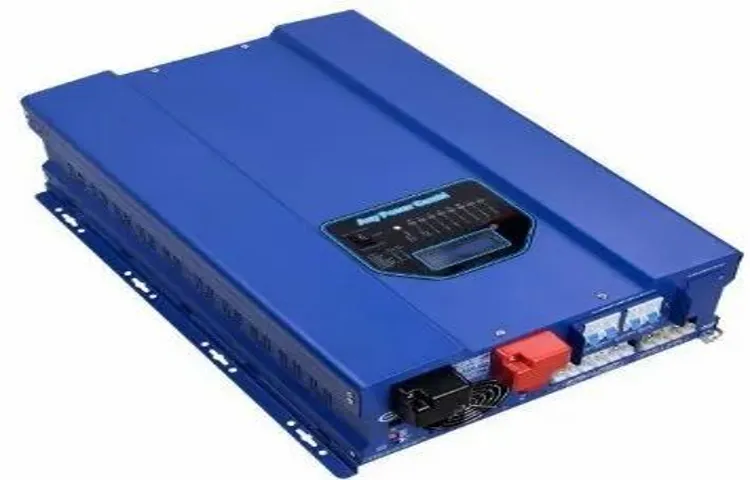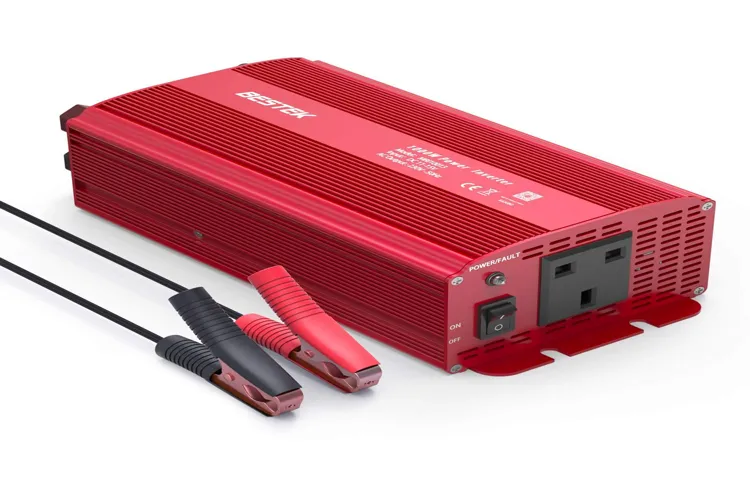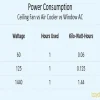Hey there, power enthusiasts! Are you tired of running out of juice when you’re on the go? Or perhaps you’re looking to power your devices while off-grid? Well, you’re in luck because today we’re talking about calculating power requirements for a 12V battery and power inverter. Imagine your 12V battery as the heart of your power system, pumping energy to your devices. However, just like the human body, you can’t expect it to sustain everything without knowing how much power is needed.
That’s where the power requirements calculation comes in! Think of it as a puzzle. You have different electronic devices with varying power needs, and your task is to figure out how to provide enough energy to keep them running smoothly. By understanding the power requirements of your devices and performing the necessary calculations, you’ll ensure your battery and power inverter can handle the load.
So, how do you calculate the power requirements? Well, it’s a straightforward process. First, gather all the relevant information about your devices, such as their power consumption in watts. Then, multiply the power consumption by the number of hours you expect to use the device each day.
This will give you the daily energy consumption in watt-hours (Wh). Next, consider any inefficiencies or losses in the system, such as the power inverter’s conversion efficiency. Multiply the daily energy consumption by a factor that accounts for these losses.
This will give you the total energy requirement for your battery and power inverter. Now, armed with this information, you can select a suitable 12V battery and power inverter that can handle the calculated energy requirement. Remember to choose a battery with enough capacity to provide power for the desired duration, and an inverter with enough wattage to handle the peak power demands of your devices.
By calculating the power requirements for your 12V battery and power inverter, you’ll ensure a reliable and efficient power system for all your needs, whether you’re camping in the wilderness or working on a DIY project in your garage. So, let’s dive in and unleash the power of knowledge!
Table of Contents
Introduction
Do you ever wonder how much power you can get from a 12-volt battery and power inverter? Well, let’s dive into it! A 12-volt battery is commonly used in cars, boats, and RVs. It provides a reliable source of power for various electrical devices. But how much power can it actually deliver? The answer depends on the capacity of the battery and the efficiency of the power inverter.
The capacity of a battery is measured in ampere-hours (Ah) and determines how much energy it can store. A higher capacity battery can deliver more power for a longer period of time. On the other hand, the power inverter converts the DC (direct current) power from the battery into AC (alternating current) power that can be used to run household appliances and electronics.
The efficiency of the power inverter affects the amount of power that can be delivered to your devices. So, in conclusion, the amount of power you can get from a 12-volt battery and power inverter depends on the capacity of the battery and the efficiency of the inverter.
Explanation of a 12V battery and power inverter
12V battery and power inverter

Why knowing the power requirements is important
power requirements, importance, knowing
Determining Power Consumption
Are you wondering how much power a 12V battery and power inverter can handle? Well, let me break it down for you. A 12V battery is designed to provide power at a voltage of 12 volts. This type of battery is commonly used in cars, boats, and other vehicles.
Now, let’s talk about the power inverter. A power inverter is a device that converts DC (direct current) power from the battery into AC (alternating current) power, which is what most household appliances and electronics use. The amount of power a 12V battery and power inverter can handle depends on their capacity.
The capacity of a battery is measured in amp-hours (Ah), which tells you how many amps the battery can provide for a certain amount of time. The capacity of a power inverter is measured in watts, which tells you how much power it can handle at a given moment. It is important to match the capacity of your battery and power inverter to the power demands of the appliances you want to run.
So, if you have a 12V battery with a capacity of 100Ah and a power inverter with a capacity of 500 watts, you can power devices that require up to 500 watts of power. However, keep in mind that running high-power devices for an extended period of time may drain your battery quickly. It’s always a good idea to calculate your power needs and choose a battery and power inverter that can handle your expected usage.
Identifying the devices that will be powered
In determining power consumption for your devices, it is important to first identify the devices that will be powered. This will help you understand the overall energy requirements and make informed decisions about power sources and usage. When considering the devices, think about their intended purpose and functionality.
Are they energy-intensive devices like computers or appliances, or are they smaller devices like smartphones or smartwatches? It’s also worth considering how frequently and for how long these devices will be in use. This can help you estimate the average power consumption and understand the impact it will have on your energy bill. By taking the time to identify and evaluate the devices that will be powered, you can make more informed choices about power consumption and take steps to be more energy-efficient.
Finding the power consumption of each device
Determining the power consumption of each device in your home can help you better understand how much energy is being used and potentially find areas where you can reduce your electricity usage. The power consumption of a device is typically measured in watts, and it represents the amount of electricity the device consumes when it is in use. To find the power consumption of a device, you can check the device’s user manual or look for a label on the device that provides this information.
Alternatively, you can use a power meter or energy monitor to measure the power consumption of the device directly. Once you have determined the power consumption of each device, you can calculate their energy usage by multiplying the power consumption by the number of hours the device is used each day. By understanding how much energy each device in your home consumes, you can identify energy-intensive appliances and take steps to reduce their usage, potentially saving you money on your energy bills.
Calculating the total power consumption
power consumption, calculate total power consumption, determining power consumption
Choosing a 12V Battery
When choosing a 12V battery and power inverter, it’s important to consider how much power you will need for your specific application. The power output of a 12V battery will depend on its capacity, which is usually measured in ampere-hours (Ah). A higher Ah rating means that the battery can provide more power for a longer period of time.
To determine how much power you need, you’ll first need to calculate the total power consumption of your devices. This can be done by multiplying the voltage (in this case, 12V) by the current (in amps) of each device. Add up the power consumption of all your devices to get the total power requirement.
Once you know your total power requirement, you’ll then need to choose a battery and power inverter that can handle that load. It’s important to choose a battery with a capacity that is greater than your total power requirement to ensure that it can provide power for the desired duration. Additionally, the power inverter you choose should have a power rating that is equal to or greater than your total power requirement.
It’s always a good idea to have a bit of extra capacity to account for any power fluctuations or spikes in demand. Keep in mind that the size and weight of the battery will also be factors to consider, especially if you need a portable power solution. You’ll want to choose a battery that is compact and lightweight, while still being able to provide the necessary power.
In conclusion, when choosing a 12V battery and power inverter, it’s important to consider the power requirements of your devices and choose a battery and inverter that can handle that load. Take into account the capacity of the battery, the power rating of the inverter, and any additional considerations such as size and weight.
Importance of battery capacity
12V battery
Choosing the right battery capacity based on power consumption
Choosing the right battery capacity for your 12V system is crucial to ensure optimal performance and longevity. The power consumption of your devices should be the primary factor in making this decision. If you have high-power devices that require a lot of energy, such as amplifiers or power-hungry appliances, you would typically need a battery with a higher capacity.
On the other hand, if you have low-power devices that consume less energy, like LED lights or small electronic gadgets, a battery with a lower capacity would suffice. It’s important to strike a balance between your power needs and the size of the battery to avoid overloading or underutilizing your system. By considering the power consumption of your devices, you can determine the right battery capacity for your 12V system and ensure reliable and efficient operation.
Considering other factors like battery type and size
When choosing a 12V battery, there are several factors to consider, such as battery type and size. The battery type will determine its overall performance and lifespan. There are different types of 12V batteries available, including lead-acid, lithium-ion, and AGM (absorbent glass mat) batteries.
Lead-acid batteries are the most common and affordable option, but they require regular maintenance and have a shorter lifespan. On the other hand, lithium-ion batteries are lighter, have a longer lifespan, and require little to no maintenance. AGM batteries are a popular choice for recreational vehicles and boats as they are spill-proof and perform well in high-vibration environments.
Additionally, considering the size of the battery is important. Depending on your specific needs and space constraints, you may need a smaller compact battery or a larger one with higher capacity. By taking these factors into account, you can choose the right 12V battery that best suits your requirements.
Selecting a Power Inverter
If you’re thinking about using a power inverter to convert DC power from a 12V battery to AC power for your electronic devices, it’s important to understand how much power your battery can provide and how much power the inverter can handle. The capacity of a 12V battery is typically measured in ampere-hours (Ah), which indicates how much current it can deliver over a certain period of time. To determine how long your battery can power your devices, you’ll need to calculate the power consumption of each device and divide it by the current output of the battery.
Keep in mind that power inverters also have their own efficiency rating, so you’ll need to consider that as well. It’s also important to choose a power inverter with a higher wattage rating than the total power consumption of your devices to ensure it can handle the load. By carefully selecting a power inverter based on the capacity of your 12V battery and the power requirements of your devices, you can ensure a reliable and efficient power supply for all your electronic needs.
What a power inverter does
power inverter
Matching the inverter’s power output to the devices’ power consumption
When selecting a power inverter, it is essential to match its power output to the devices you plan to use. You don’t want to get an inverter that is too small and can’t handle the power requirements of your devices. At the same time, you don’t want to get an inverter that is too big and wastes energy.
It’s like selecting the right size of shoes. If the shoes are too small, they will pinch and hurt your feet. If they are too big, they will feel loose and uncomfortable.
The same goes for inverters and your devices. You need to find the perfect match to ensure optimal performance and prevent any damage to your equipment. So, before making a decision, make sure to check the power requirements of your devices and choose an inverter that can handle their power consumption.
Considering additional features like surge power and wave type
When selecting a power inverter, it’s important to consider additional features like surge power and wave type. Surge power refers to the maximum amount of power that an inverter can handle for a short period of time. This is important because certain appliances, like refrigerators or air conditioners, require a higher initial power surge to start up.
So if you plan on using these types of appliances with your inverter, you’ll want to make sure it has a high surge power rating to handle these bursts of energy. Wave type is another important feature to consider. There are two main types of waves that inverters produce: modified sine wave and pure sine wave.
Modified sine wave inverters are more affordable but can cause issues with certain sensitive electronics, like laptops or audio equipment. On the other hand, pure sine wave inverters produce a smoother and more consistent wave, making them compatible with all types of electronics. So if you plan on using a variety of devices, it’s best to opt for a pure sine wave inverter to avoid any potential problems.
Overall, when selecting a power inverter, it’s important to think about your specific power needs and the types of devices you plan on using. Considering features like surge power and wave type will ensure that you choose an inverter that is capable of providing reliable and safe power for all your needs.
Conclusion
So, to sum it all up, the power of a 12V battery and power inverter is a force to be reckoned with. It’s like having the ultimate genie granting you the power to run various electronic devices on the go. With its ability to convert DC power into AC power, it’s like having a portable energy source that can bring life to your gadgets wherever you may roam.
Think of it this way. The 12V battery is the basecamp, full of potential energy just waiting to be tapped into. And the power inverter is the mastermind, the wizard that turns that potential energy into the magical AC power that your devices crave.
Together, they create a dynamic duo that can charge your phone, power your laptop, or even transform your camping trip into a van Gogh-worthy digital nomad escape. But let’s not forget about the resourcefulness of the power inverter. It’s not just a one-trick pony.
It can adapt to different voltages and frequencies, accommodating a wide range of devices. It’s like a chameleon, blending seamlessly into any power grid and providing the voltage needed to keep your electronics humming. And let’s not downplay the importance of efficiency in this power-packed equation.
With a high-quality power inverter, you can tap into the maximum potential of your 12V battery and ensure that you’re getting the most energy for your buck. It’s like having a money-saving superpower, reducing your electricity bill and leaving more cash in your pocket for other life adventures. So, the next time you find yourself in need of power on the go, remember the unstoppable force that is a 12V battery and power inverter.
They’re the dynamic duo that can bring electricity to even the most remote corners of the world. Just like Batman and Robin, they’re here to save the day and keep your devices powered up, no matter where your adventures take you.
Summary of the key points discussed
power inverter, selecting a power inverter, inverters, power requirements, appliances, sine wave, modified sine wave, pure sine wave, efficiency, overload protection, voltage regulation, inverter capacity, battery capacity, continuous power, peak power, surge capacity Summary: Selecting the right power inverter for your needs involves considering several key points. First, you need to assess your power requirements by determining the appliances you want to run with the inverter. Different appliances have different power requirements, and this will determine the size and capacity of the inverter you need.
Next, you need to understand the difference between sine wave, modified sine wave, and pure sine wave inverters. Pure sine wave inverters produce a smoother and cleaner power output, making them more compatible with sensitive electronics. However, modified sine wave inverters are more cost-effective and can power most household appliances.
Efficiency, overload protection, and voltage regulation are other important factors to consider when selecting an inverter. Finally, you need to ensure that the inverter capacity matches the battery capacity to avoid any power shortages. Understanding the concepts of continuous power, peak power, and surge capacity will help you choose the right inverter to meet your power needs.
Importance of accurately calculating power requirements
Selecting the right power inverter is crucial when it comes to accurately determining your power requirements. Whether you are using it for your car, RV, or boat, having the correct power inverter is essential to ensure that all your electronic devices run smoothly. The power inverter converts the direct current (DC) from your battery into alternating current (AC) which is used by most household appliances.
To select the right power inverter, you need to consider the wattage requirements of your devices. It is important to accurately calculate the power requirements of all the devices you plan to connect to the inverter to ensure it can handle the load. Overloading the inverter can cause it to overheat or even burn out, so it is better to err on the side of caution and choose an inverter with a higher wattage rating than what you actually need.
Additionally, you should also consider the inverter’s surge capacity, which refers to its ability to handle brief, high-power demands. Devices like refrigerators or air conditioners have a high surge capacity, so you need to make sure your inverter can handle that extra power surge. By accurately calculating your power requirements and selecting the right power inverter, you can ensure that all your electronic devices operate smoothly and efficiently.
Tips for choosing the right 12V battery and power inverter
When it comes to selecting a power inverter for your 12V battery, there are a few important factors to consider. First, you’ll want to determine the power requirements of your devices. This includes both the continuous power (the amount of power needed to keep your device running) and the peak power (the amount of power needed to start your device).
It’s important to choose an inverter that can handle the peak power requirements of your devices. Additionally, you’ll want to consider the efficiency of the inverter. A more efficient inverter will convert a higher percentage of the battery’s power into usable electricity, maximizing the runtime of your devices.
Finally, you’ll want to think about the size and portability of the inverter. If you plan to use it on the go, a compact and lightweight option may be more suitable. By considering these factors, you can choose the right power inverter to meet your needs and ensure that your devices can run smoothly on your 12V battery.
FAQs
How much power can a 12V battery provide?
The power output of a 12V battery can vary depending on its capacity. However, a typical 12V car battery can provide around 500-700 watts of power.
What factors determine the power output of a 12V battery?
The power output of a 12V battery is determined by its capacity (measured in ampere-hours) and the discharge rate. Higher capacity batteries and lower discharge rates generally provide more power.
Can a 12V battery power a refrigerator through a power inverter?
Yes, a 12V battery can power a refrigerator through a power inverter. However, it is important to consider the power requirements of the refrigerator and the capacity of the battery to ensure it can provide enough power for the desired duration.
How long can a 12V battery power a 1000-watt power inverter?
The available power and duration will depend on the capacity of the 12V battery. As a rough estimate, a 100Ah capacity battery can power a 1000-watt power inverter for approximately 1-2 hours.
What size power inverter do I need for a 12V battery?
To determine the appropriate size power inverter for a 12V battery, you need to consider the maximum power consumption of the devices you intend to run. As a general rule, it is recommended to select an inverter that can handle at least 20% more power than the total load.
Can a 12V battery power a microwave through a power inverter?
Yes, a 12V battery can power a microwave through a power inverter. However, microwaves typically require a higher wattage (800-1500 watts), so it is important to ensure the battery and inverter can provide enough power.
How long can a 12V battery power a laptop through a power inverter?
The power consumption of a laptop can vary, but for estimation purposes, a 12V battery with a capacity of 50Ah can power a laptop for approximately 4-6 hours through a power inverter.



